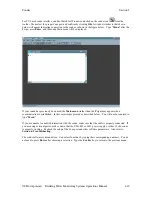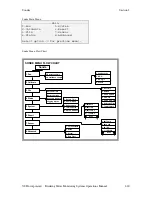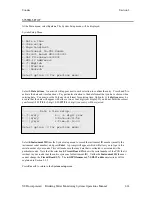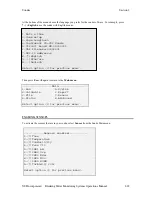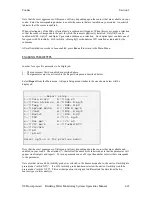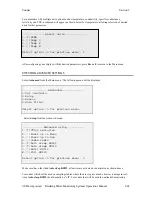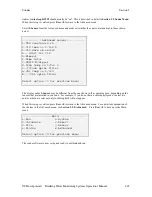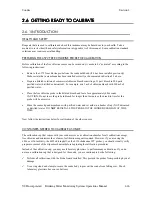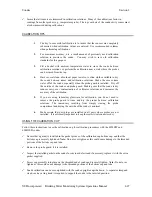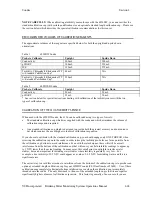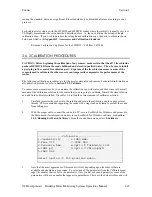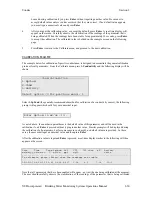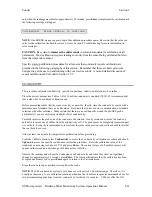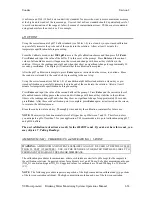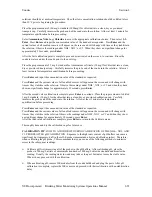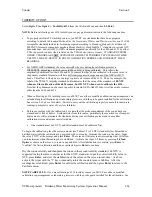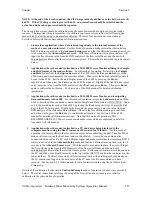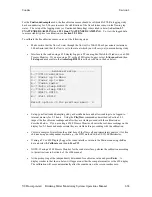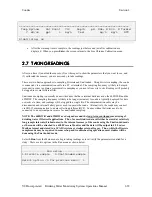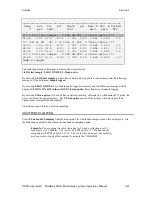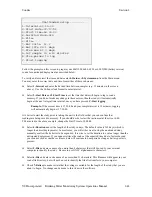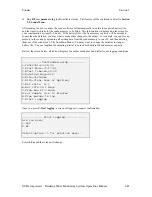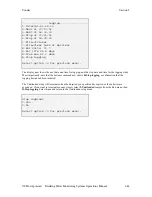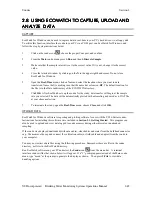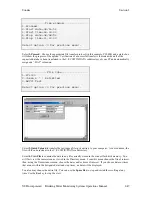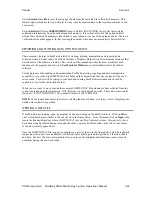
Sondes
Section
2
YSI Incorporated
Drinking Water Monitoring Systems Operations Manual
2-33
solutions should be at ambient temperature. The other low concentration solution should be chilled to less
than 10
°
C prior to beginning the procedure.
Place the proper amount of 100 mg/L standard (1000mg/l for chloride) into a clean, dry or pre-rinsed
transport cup. Carefully
immerse the probe end of the sonde into the solution. Allow at least 1 minute for
temperature equilibration before proceeding.
Select
Ammonium, Nitrate,
or
Chloride
to access the appropriate calibration choices. Then select
3-3-
Point
. Press
Enter
and input the concentration value of the standard as requested. Press
Enter
and the
current values of all enabled sensors will appear on the screen and will change with time as they stabilize in
the solution. Observe the readings under NH4
+
, NO3
-
, or Cl
-
. When they show no significant change for
approximately 30 seconds, press
Enter
.
After the first calibration point is complete, proceed as instructed on the screen, to continue. Rinse the
sonde in water and dry the sonde prior to the next step.
Place the proper amount of 1 mg/L standard for Ammonium or Nitrate (10 mg/l for Chloride) into a clean,
dry or pre-rinsed transport cup. Carefully
immerse the probe end of the sonde into the solution. Allow at
least 1 minute for temperature equilibration before proceeding.
Press
Enter
and input the concentration value of the standard as requested.
Press
Enter
and the current values of all enabled sensors will appear on the screen and will change with
time as they stabilize in the solution. Observe the readings under NH4
+
, NO3
-
, or Cl
-
.and when they have
show no significant change for approximately 30 seconds, press
Enter
.
After the second value calibration is complete, press
Enter
to continue. Place the proper amount of chilled
1 mg/L standard (10 mg/L for the chloride) into a clean, dry or pre-rinsed calibration cup. Carefully
immerse the probe end of the sonde into the solution. Allow at least 5 minutes for temperature
equilibration before proceeding.
Press
Enter
and input the concentration value of the standard as requested.
Press
Enter
and the current values of all enabled sensors will appear on the screen and will change with
time as they stabilize in the solution. Observe the readings under NH4
+
, NO3
-.
or Cl
-.
and when they show
no significant change for approximately 30 seconds, press
Enter
.
After the third value calibration is complete, press
Enter
to return to the Calibrate menu.
Thoroughly rinse and dry the calibration cups for future use.
CALIBRATION TIP
: HOW TO AVOID DRIFT DURING CALIBRATION OF THE NH4+, NO3- AND
Cl- PROBES AFTER pH CALIBRATION. Exposure to the high ionic content of pH buffers can cause a
significant, but temporary, drift in these ISE probes (ammonium, nitrate and chloride probes). Therefore,
when calibrating the pH probe, YSI recommends that you use one of the following methods to minimize
errors in the subsequent readings:
¾
Calibrate pH first, immersing all of the probes in the pH buffers. After calibrating pH, place the
probes in 100 mg/L nitrate or ammonium standard or 1000 mg/L chloride standard and monitor the
reading. Usually, the reading starts low and may take as long as 30 minutes to reach a stable value.
When it does, proceed with the calibration.
¾
When calibrating pH, remove ISE modules from the sonde bulkhead and plug the ports. After pH
calibration is complete, replace the ISE sensors and proceed with their calibration with no stabilization
delay.

